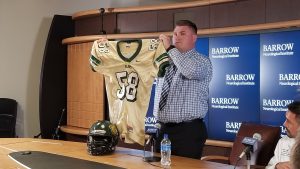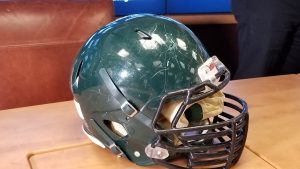- Slug: Sports-Concussion Report Ellis. 1,050 words.
- Photos available
By Ricardo Ávila
Cronkite News
PHOENIX — Basha and Cesar Chavez high schools were battling it out in the third game of the football season. As the clock ticked down toward the end of the first quarter, Cesar Chavez threatened to score.
On fourth down and goal, the only thing stopping Cesar Chavez was one player: senior defensive end Wyatt Ellis. A five-star recruit being pursued by Arizona State coach Todd Graham, he saw a running back powering toward the end zone and dove head-first to stop him.
And then the lights went out.
A day later, Ellis woke up at St. Joseph’s Hospital and Medical Center from a medically induced coma, intubated and with doctors and security staff having to hold him down because he was panicking. He soon learned that he had suffered a concussion and that he had tackled with such force that both his helmet and the running back’s chest plate were cracked open.
The scene that unfolded that night at Cesar Chavez is one that many parents fear their son or daughter might experience competing in contact sports. That’s the message from a recent survey on concussions among high school athletes by the Barrow Neurological Institute, which showed that 58 percent of parents would allow their children to play football, a drop of 8.8 percent since 2016.
“We feel that all of this is driving a decline in sports participation, specifically in football. We find that more parents are restricting their children from participating in football,” said Dr. Javier Cárdenas, neurologist and director of the Barrow Concussion and Brain Injury Center at St. Joseph’s. He announced the results of the survey during a press conference with Ellis by his side and the busted football helmet displayed.
On that night in 2014, Ellis had lost consciousness. As he attempted to get up, he felt confused. He didn’t know where he was, and he didn’t know what was happening. He had lost all feeling on the right side of his body and collapsed before being rushed to the hospital.
After numerous medical appointments, Ellis met with Cárdenas. Doctors found two brain hemorrhages and that is when Cárdenas recommended that he give up football.
“I was about to go play at Arizona State. And it ended right there,” said Ellis, a tear rolling down his cheek.
Cárdenas emphasized three main points from the survey using Ellis as an example of the consequences of concussions.
First, he said 20 percent of Arizona high school athletes reported sustaining a sports-related concussion.
Second, a fourth of teenagers said they decided not to play a sport because of concerns about concussions.
And finally, 78 percent of those who have experienced a concussion are concerned about the potential long-term consequences of the injury.
Ellis said he still has a constant ringing sensation in his ears, which he compared to a freight train approaching. And Cárdenas warned Ellis that if he stepped back onto the field and took another hit similar to the one on that night four years ago, “at that point you’re not going to wake up again.”
To educate young athletes about concussions, Barrow launched a concussion education program called Brainbook in 2011. It has since provided concussion education to more than 400,000 Arizona high school athletes.
Brainbook is an online course that all high school athletes registered under the Arizona Interscholastic Association must complete before participation in any AIA-sanctioned practice or competition.
Athletes also are required to have an annual physical evaluation and each must sign, along with a parent, a concussion statement and acknowledgement form each year.
The AIA also states all participating schools must have a concussion policy on file, addressing education, guidelines for an athlete’s removal from competition and requirements to return to play.
Other than that, there is no method in place to actively monitor concussions among high school athletes in Arizona.
The AIA’s Return to Play criteria requires athletes have clearance from an appropriate health care professional to return to practice and competition.
Athletes can’t return to play or practice on the same day of a concussion, and can only return to play after they have resumed full school attendance, according to the AIA.
Appropriate health care professionals approved by the AIA are licensed athletic trainers, physicians, licensed nurse practitioners and a physician’s assistant.
The AIA has 267 member schools, according to AIA Executive Director David Hines. Even though some schools conduct baseline testing, it is not required by the AIA and the tests do not determine whether or not an athlete has previously suffered a concussion, Hines said.
“We have to rely on education,” he said.
Hines believes athletics are important for teenagers, but athletes have to be smart and know the risks that come with their sport.
Cárdenas said Barrow is not discouraging teens from playing sports by publishing the survey. He only wants to make them aware of the possible consequences that come with competing in contact sports.
“We are attempting to minimize those risks,” Cárdenas said. “The most concerning statistic to me is the fact that many families and athletes feel they have not been exposed to the education.”
Available on Barrow’s website, the survey results show 25 percent of Arizona teens who have played sports said they have not received concussion education.
Cárdenas said in order to improve concussion awareness and education in Arizona, Barrow will attempt to work more closely with club sports, which are outside of AIA jurisdiction, and work to expand Brainbook locally and nationally.
Hines agreed. He said the biggest challenge the AIA has is that its jurisdiction only includes member schools.
Ellis’ life changed after the concussion. It was as if he went from being a senior in high school back to being in the first grade.
Rather than going to the gym, practice and back to the gym, his time was spent learning how to talk again.
He went from being a five-star athlete and an ASU recruit to being taught how to spell “dog.”
A criminal justice major at ASU who hopes to graduate in about a year, Ellis said that despite all of the past and current side effects, if Cárdenas hadn’t recommended that he stop, he would still be splitting double teams and chasing down running backs to this day.
Follow us on Twitter.
For more stories from Cronkite News, visit cronkitenews.azpbs.org.

